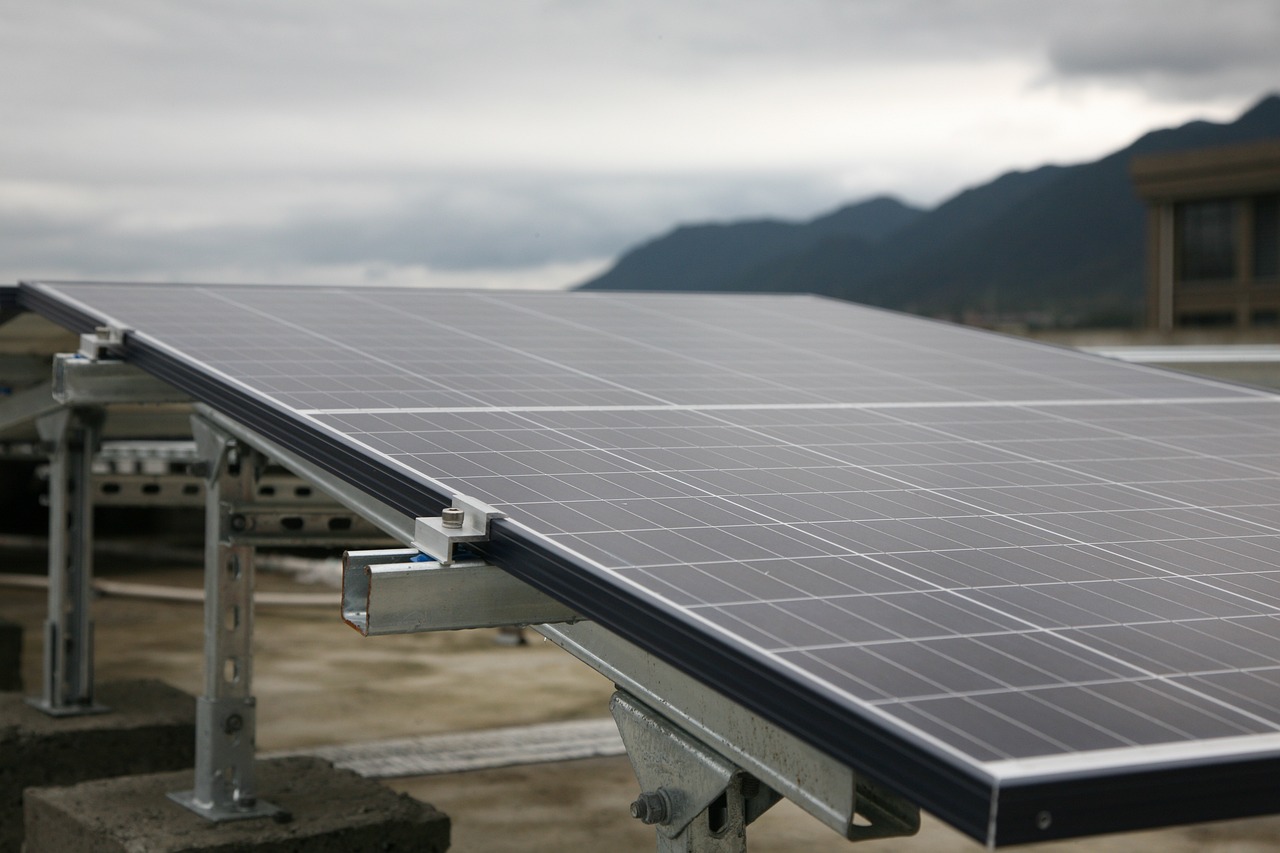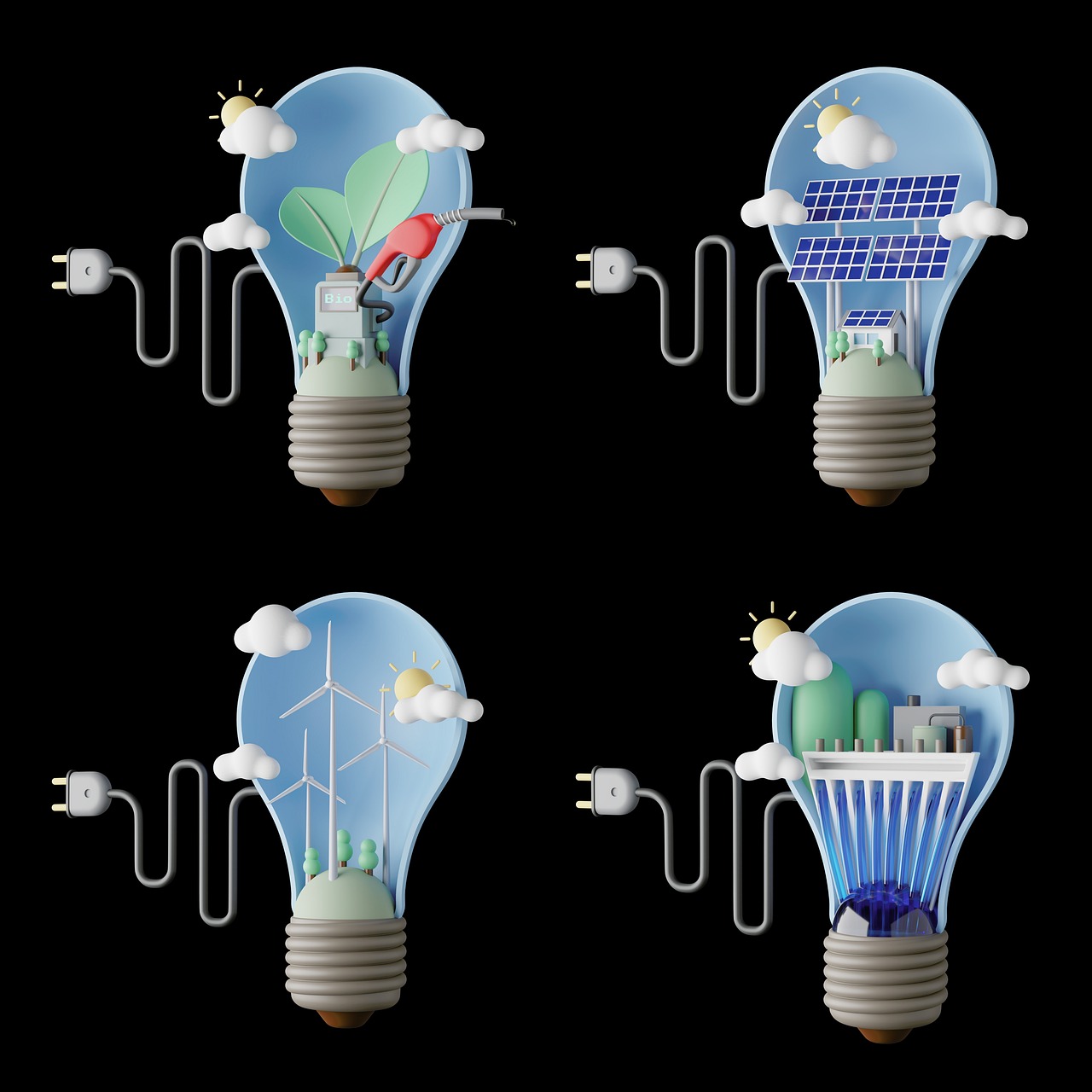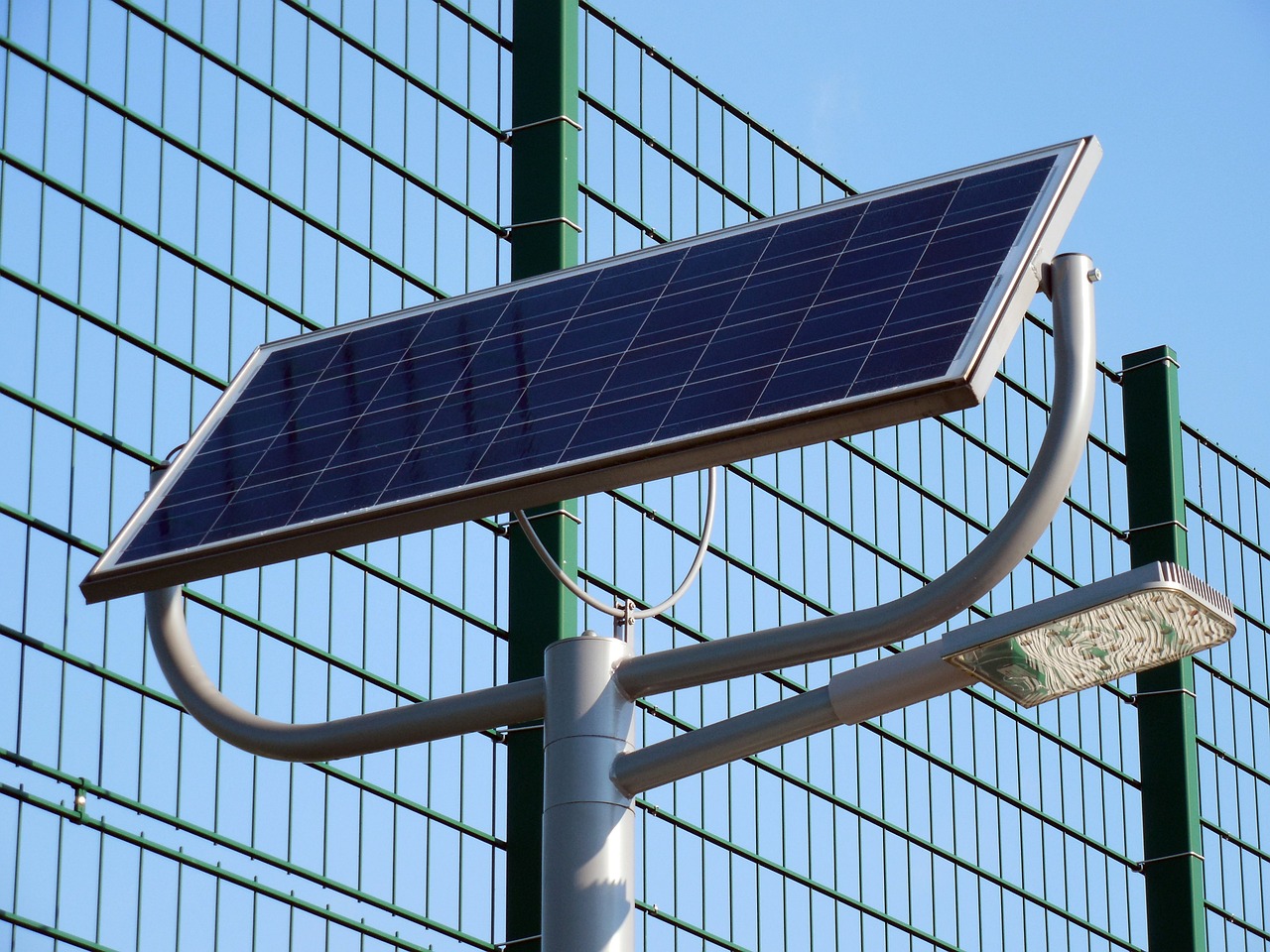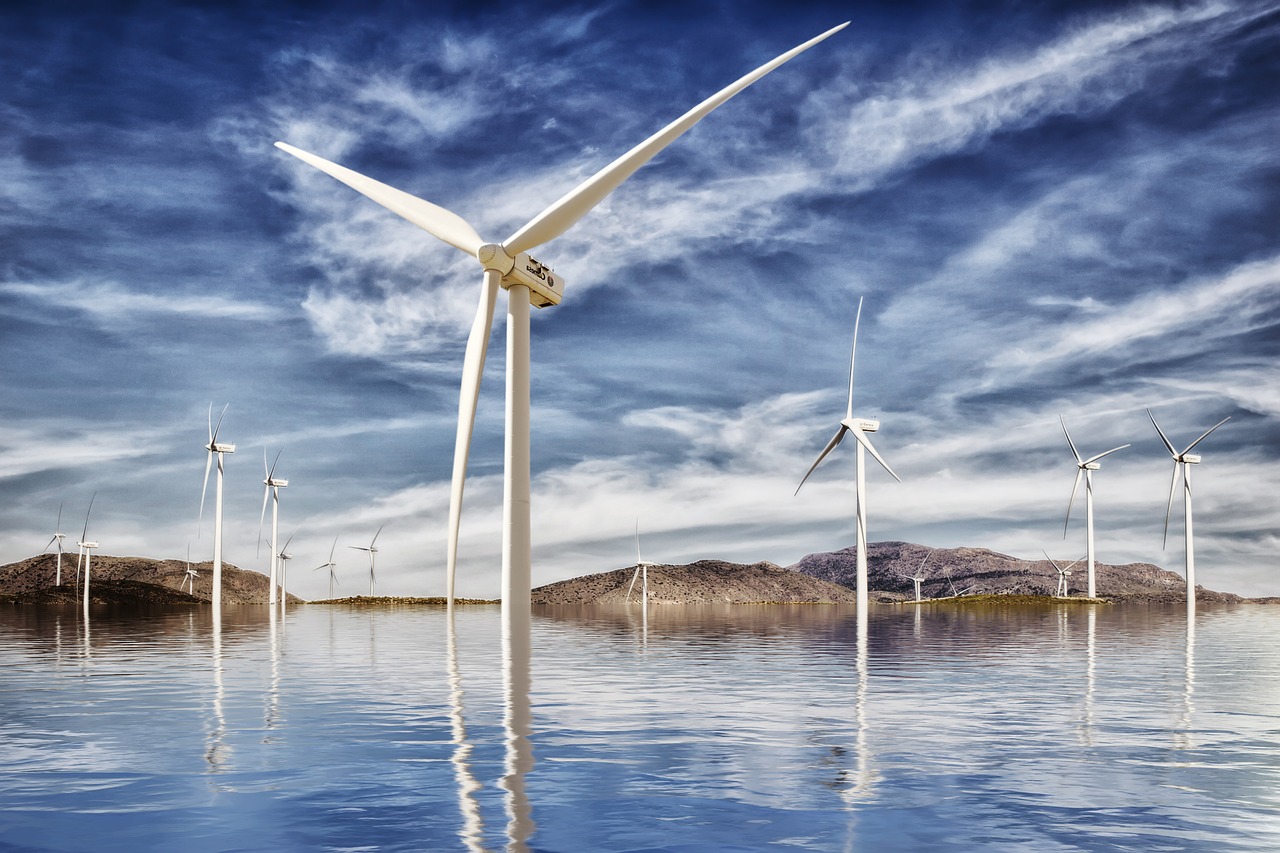How Covid-19 is Accelerating the Push for Green Energy
The Covid-19 pandemic has been a transformative force in many aspects of our lives, and one of the most significant changes has been in the energy sector. As the world grappled with the immediate effects of the virus, it became clear that our reliance on fossil fuels was not just a matter of convenience but a pressing issue of sustainability. The crisis has acted as a catalyst, accelerating the shift towards green energy solutions and practices that many had long advocated for. This article delves into how the pandemic has reshaped the global energy landscape, highlighting the increased demand for renewable energy sources and the pivotal role they will play in our future.
When the pandemic hit, energy consumption patterns changed dramatically. With businesses shutting down and people staying home, there was a significant reduction in the demand for fossil fuels. The streets were eerily quiet, and the usual hustle and bustle of urban life came to a standstill. This unprecedented situation led to a notable decrease in carbon emissions, prompting many to rethink their energy consumption habits. As economies began to reopen, the focus shifted towards renewable energy sources such as solar, wind, and hydroelectric power, which not only proved to be more sustainable but also more resilient in times of crisis.
In response to the challenges posed by Covid-19, numerous governments worldwide have stepped up to implement policies and incentives aimed at promoting green energy initiatives. These measures are designed not just to recover from the economic fallout of the pandemic but also to pave the way for a more sustainable future. For instance, many countries are offering tax breaks and grants for renewable energy projects, encouraging both businesses and individuals to invest in cleaner technologies. This strategic shift is not merely a reaction to the pandemic; it reflects a growing recognition of the need to combat climate change and foster a greener economy.
The pandemic has also prompted a reevaluation of investment strategies, with many investors now prioritizing renewable technologies over traditional fossil fuels. The financial community is increasingly recognizing the long-term viability and profitability of green energy solutions. As a result, we are witnessing a surge in funding for innovative technologies such as solar panels, wind turbines, and energy storage solutions. This influx of capital is crucial for accelerating the development and deployment of these technologies, which are essential for a sustainable energy future.
One of the silver linings of the transition to green energy is the potential for job creation. While the pandemic led to significant job losses across many sectors, the renewable energy industry is poised to create numerous opportunities. As companies invest in sustainable practices and technologies, there will be a growing demand for skilled workers in fields such as engineering, installation, and maintenance of renewable energy systems. This shift not only helps in economic recovery but also contributes to a more resilient job market in the long run.
Despite the positive momentum towards green energy, the transition is not without its challenges. Supply chain disruptions caused by the pandemic have affected the availability of materials needed for renewable energy projects. Additionally, the need for technological advancements remains critical. To fully realize the potential of green energy, ongoing research and development are essential. Governments, private sectors, and academic institutions must collaborate to overcome these hurdles and ensure a smooth transition to sustainable energy solutions.
The Covid-19 crisis has heightened public awareness of environmental issues, leading to a surge in support for green energy initiatives. People are becoming more conscious of their consumption patterns and the impact they have on the planet. This newfound awareness is translating into action, with consumers increasingly demanding sustainable products and practices from businesses. The shift in consumer behavior is a powerful driver for companies to adopt greener practices and invest in renewable energy sources.
In light of the pandemic, many corporations are reevaluating their sustainability goals. The crisis has underscored the importance of corporate responsibility, prompting companies to commit to greener practices. By integrating sustainable solutions into their operations, businesses not only enhance their brand image but also contribute to a healthier planet. This commitment to sustainability is becoming a competitive advantage in a market that increasingly values environmental stewardship.
Several companies have successfully integrated green energy solutions into their operations, serving as beacons of sustainability for others to follow. For example, Company A has transitioned to 100% renewable energy sources, significantly reducing its carbon footprint. Similarly, Company B has implemented innovative recycling programs that minimize waste and promote sustainability. These case studies highlight the tangible benefits of embracing green energy and serve as inspiration for others in the quest for sustainability.
The pandemic has prompted businesses to align their long-term sustainability goals with the global push for green energy. Companies are recognizing that resilience in the face of future crises depends on their ability to adapt and innovate. By committing to sustainable practices, businesses not only contribute to a healthier planet but also position themselves for success in a rapidly changing world. The journey towards sustainability is ongoing, but the lessons learned from Covid-19 will undoubtedly shape the future of energy.
- How has Covid-19 impacted the energy sector?
The pandemic has led to a significant reduction in fossil fuel use and increased reliance on renewable energy sources. - What policies are governments implementing to promote green energy?
Many governments are offering tax breaks and grants for renewable energy projects to encourage investment. - Will transitioning to green energy create jobs?
Yes, the renewable energy sector is expected to create numerous job opportunities, countering pandemic-related job losses. - What challenges does the green energy transition face?
Challenges include supply chain disruptions and the need for ongoing technological advancements.

The Shift in Energy Demand
The Covid-19 pandemic has dramatically reshaped our world, and one of the most significant changes has been in energy demand. As lockdowns took hold and people began to work from home, the traditional patterns of energy consumption shifted almost overnight. Suddenly, the bustling offices and crowded public spaces that once consumed vast amounts of energy were eerily quiet. This shift has led to a remarkable reduction in the use of fossil fuels, as many industries ground to a halt and transportation plummeted.
Interestingly, while fossil fuel consumption took a nosedive, the demand for renewable energy sources began to rise. With more people at home, residential energy consumption surged, and many households turned to cleaner energy options. Solar panels on rooftops became more than just a trend; they became a necessity for many families looking to reduce their energy bills while also contributing to the planet's health. This shift illustrates a fundamental change in our energy landscape, as consumers increasingly prioritize sustainability.
To put this into perspective, consider the following table that outlines the changes in energy consumption during the pandemic:
| Energy Source | Pre-Pandemic Consumption | Pandemic Consumption | Change (%) |
|---|---|---|---|
| Fossil Fuels | 75% | 60% | -20% |
| Renewable Energy | 25% | 40% | +60% |
This table clearly illustrates how the pandemic has catalyzed a shift in energy demand, with renewable sources gaining ground while fossil fuels are pushed to the sidelines. The transition is not just a temporary blip; it represents a fundamental shift in how we think about energy consumption. As we become more aware of our environmental impact, the push for sustainable energy solutions is not just a trend—it's becoming a necessity.
Moreover, the pandemic has highlighted the vulnerabilities in our existing energy systems. With supply chains disrupted and energy prices fluctuating, many countries are now realizing the importance of energy independence and resilience. This realization is driving governments and businesses alike to invest in renewable energy infrastructure, ensuring that we are better prepared for future crises.
As we look to the future, the question remains: will this shift in energy demand be a temporary response to a global crisis, or will it mark the beginning of a new era in sustainable energy? Only time will tell, but one thing is certain: the seeds of change have been planted, and they are beginning to sprout.
- What are the main factors driving the shift towards renewable energy?
Factors include reduced fossil fuel consumption during the pandemic, increased public awareness of environmental issues, and government policies promoting sustainability. - How has Covid-19 affected energy prices?
Energy prices have seen significant fluctuations due to changes in demand and supply chain disruptions, particularly in fossil fuel markets. - Will the shift to renewable energy continue post-pandemic?
Many experts believe that the momentum gained during the pandemic will continue, driven by both consumer demand and corporate responsibility.

Government Policies and Incentives
The Covid-19 pandemic has acted as a catalyst for change across multiple sectors, and the energy landscape is no exception. As governments grapple with the dual challenges of economic recovery and environmental sustainability, many are stepping up to implement robust policies and incentives aimed at fostering a greener future. This shift is not just about meeting immediate energy demands; it's about laying the groundwork for a sustainable economy that can withstand future crises.
One of the most significant trends we've seen is the introduction of financial incentives for renewable energy projects. Governments worldwide are offering tax credits, grants, and subsidies to encourage both businesses and individuals to invest in green technologies. For instance, in the United States, the Investment Tax Credit (ITC) allows homeowners and businesses to deduct a substantial percentage of the cost of solar energy systems from their federal taxes. This not only makes solar energy more accessible but also stimulates job creation in the renewable sector.
Furthermore, many governments are revising their energy policies to prioritize renewable sources over fossil fuels. This includes setting ambitious targets for reducing greenhouse gas emissions and increasing the share of renewables in the energy mix. For example, the European Union has committed to becoming carbon-neutral by 2050, which has led to a surge in investment in wind and solar power across member states. These policies are not just aspirational; they are backed by strict regulations and compliance measures that hold corporations accountable.
Another critical aspect of government initiatives is the establishment of green recovery plans. These plans are designed to ensure that economic recovery from the pandemic is intertwined with environmental sustainability. Countries like Canada and New Zealand have launched comprehensive recovery packages that focus on green infrastructure projects, such as public transportation systems powered by renewable energy. This approach not only addresses immediate economic needs but also sets the stage for long-term sustainability.
However, the effectiveness of these policies often depends on public support and awareness. Governments are increasingly engaging with communities to raise awareness about the benefits of green energy, ensuring that citizens are informed and involved in the transition. This grassroots approach fosters a sense of ownership and responsibility among the public, encouraging more people to adopt sustainable practices in their daily lives.
While the push for green energy is gaining momentum, it's essential to recognize that challenges remain. Issues such as funding shortages for renewable projects and the need for technological advancements can hinder progress. Nevertheless, the commitment shown by governments to create a supportive policy environment is a promising sign that the transition to green energy is not just a fleeting trend but a fundamental shift in how we think about energy consumption and sustainability.
In summary, the pandemic has propelled governments to rethink their energy policies, leading to a wave of incentives designed to promote green energy. By investing in renewable technologies and encouraging public participation, these initiatives are paving the way for a more sustainable and resilient future.
- What types of incentives are available for renewable energy projects?
Governments often offer tax credits, grants, and subsidies to encourage investment in renewable technologies. - How are governments ensuring public support for green energy?
Many governments engage with communities to raise awareness and promote the benefits of renewable energy. - What challenges do governments face in promoting green energy?
Challenges include funding shortages and the need for technological advancements. - Are there any international commitments to green energy?
Yes, countries like those in the European Union have set ambitious targets for carbon neutrality by 2050.

Investment in Renewable Technologies
The Covid-19 pandemic has acted as a catalyst for a seismic shift in the investment landscape, particularly in the realm of renewable technologies. As traditional industries faced unprecedented challenges, investors began to pivot towards more sustainable options. This shift isn't just a trend; it's a profound transformation that signals a commitment to a greener future. With the world grappling with the fallout of the pandemic, the urgency to address climate change has never been more pronounced. Investors are now viewing renewable energy not just as a niche market, but as a vital component of a resilient and sustainable economy.
In 2020, global investments in renewable energy technologies reached staggering new heights, driven by a combination of government policies, technological advancements, and a growing public demand for cleaner energy sources. According to the International Energy Agency (IEA), investments in renewables surged to over $300 billion, a clear indication that the market is ready to embrace change. This influx of capital is not just beneficial for the environment; it also presents an array of economic opportunities. For example, companies that specialize in solar, wind, and energy storage technologies are witnessing unprecedented growth, attracting both venture capital and institutional investments.
Moreover, the pandemic has highlighted the vulnerabilities of fossil fuel markets, which are often subject to volatility and geopolitical tensions. In contrast, renewable technologies offer a more stable investment avenue with long-term benefits. As we look towards the future, the diversification of energy sources is becoming increasingly important. By investing in renewables, we are not only addressing immediate energy needs but also laying the groundwork for a sustainable energy infrastructure that can withstand future crises.
One of the most exciting developments in this space is the rapid advancement in energy storage solutions. As renewable energy sources like solar and wind become more prevalent, the need for efficient storage systems is paramount. These technologies allow for energy to be stored during peak production times and utilized during periods of high demand. This innovation is crucial for enhancing the reliability of renewable energy, making it a more attractive option for investors.
Furthermore, government incentives play a pivotal role in this investment surge. Many countries have introduced tax breaks, subsidies, and grants aimed at encouraging the adoption of renewable technologies. These policies not only stimulate growth in the sector but also reassure investors that their capital is being directed towards sustainable initiatives. For instance, the U.S. government has extended the Investment Tax Credit (ITC) for solar energy projects, which has significantly boosted investment in this area.
In summary, the pandemic has not only accelerated the transition towards renewable technologies but has also redefined the investment landscape. As more investors recognize the potential of green energy, we can expect to see a continued influx of capital into this sector. The future is bright for renewable technologies, and with the right support and investment, we can pave the way for a sustainable and resilient energy future.
- What are renewable technologies?
Renewable technologies refer to energy sources that are replenished naturally, such as solar, wind, hydroelectric, and geothermal energy. - Why is investment in renewable technologies important?
Investing in renewable technologies is crucial for reducing greenhouse gas emissions, combating climate change, and creating a sustainable energy future. - How has Covid-19 affected renewable energy investments?
The pandemic has accelerated investments in renewable energy as investors seek stable, sustainable alternatives to fossil fuels. - What role do government policies play in renewable energy investment?
Government policies, such as tax incentives and subsidies, encourage investments in renewable technologies by reducing financial risks for investors.

Impact on Job Creation
The transition to green energy is not just a buzzword; it’s a revolution that has the potential to reshape the job market significantly. As the world grapples with the economic fallout from the Covid-19 pandemic, the renewable energy sector stands out as a beacon of hope, promising to create numerous job opportunities. Imagine a world where the energy sector not only powers homes but also fuels livelihoods. This shift is akin to planting seeds in a garden; with the right conditions, they will grow and flourish into something magnificent.
According to recent studies, the renewable energy industry is expected to create millions of jobs in the coming years. The International Renewable Energy Agency (IRENA) reported that the sector employed over 11 million people globally in 2018, and that number is projected to rise as investments in solar, wind, and other sustainable technologies increase. This growth is essential, especially in the wake of the pandemic, which has caused widespread job losses across various sectors. The renewable energy sector is like a phoenix rising from the ashes, offering a path to recovery and resilience.
To illustrate the potential impact on job creation, consider the following table that outlines various renewable energy sources and their job creation potential:
| Renewable Energy Source | Jobs Created per Megawatt (MW) |
|---|---|
| Solar Energy | 5.65 |
| Wind Energy | 3.68 |
| Hydropower | 1.17 |
| Biomass | 2.60 |
This table highlights the significant job creation potential of different renewable energy sources. For instance, solar energy alone can create over 5 jobs for every megawatt installed. This is a stark contrast to fossil fuels, which have been on a steady decline, both in terms of demand and job opportunities. The renewable energy sector is not just about creating jobs; it’s about fostering new skills and building a workforce that is prepared for the future.
Moreover, the jobs created in the green energy sector are often more resilient to economic fluctuations. They tend to be more stable and offer opportunities for career advancement. As companies invest in training and development, workers are equipped with the skills needed to thrive in this evolving landscape. It’s like giving them a toolbox filled with the right instruments to build a sustainable future.
However, it’s essential to acknowledge that the transition to green energy also comes with challenges. Workers from traditional energy sectors may face difficulties in adapting to new roles. To address this, many governments and organizations are implementing retraining programs to help these individuals transition smoothly into renewable energy jobs. This proactive approach is crucial in ensuring that no one is left behind in this green revolution.
In conclusion, the impact of the shift towards green energy on job creation is profound and multifaceted. It offers a pathway to recovery from the pandemic while simultaneously addressing pressing environmental issues. As we navigate this transition, it’s vital to foster a culture of inclusivity and support for workers, ensuring that the green energy boom benefits everyone. Are we ready to embrace this change and build a brighter, more sustainable future?
- What types of jobs are available in the green energy sector?
The green energy sector offers a variety of jobs, including solar panel installers, wind turbine technicians, energy efficiency consultants, and researchers in sustainable technologies.
- How can I transition to a job in renewable energy?
Many community colleges and online platforms offer courses in renewable energy technologies. Additionally, gaining experience through internships can be invaluable.
- Are green energy jobs stable?
Yes, jobs in the renewable energy sector tend to be more stable compared to traditional fossil fuel jobs, as the demand for clean energy continues to grow.

Challenges in the Transition
The journey towards a greener energy landscape is not without its hurdles. As we strive to pivot away from fossil fuels and embrace renewable energy sources, we encounter a series of challenges that could potentially slow down this transformation. One of the most pressing issues is the disruption of supply chains. The pandemic has exposed vulnerabilities in global logistics, making it difficult to source materials needed for renewable technology production. For instance, the availability of critical components like solar panels and wind turbine parts has been affected, causing delays in projects that are essential for meeting our green energy goals.
Another significant challenge is the need for technological advancements. While we have made remarkable progress in renewable technologies, there is still a considerable gap in efficiency and energy storage capabilities compared to traditional energy sources. For example, the efficiency of solar panels has improved, but we still require breakthroughs in energy storage to ensure that we can rely on solar energy even when the sun isn’t shining. This is where research and development become crucial. Governments and private sectors must invest in innovation to overcome these technological barriers.
Moreover, there is the challenge of public acceptance and behavioral change. Transitioning to green energy isn’t just about technology; it’s also about people. Many consumers are still hesitant to adopt renewable energy solutions due to misconceptions or a lack of understanding. Educational initiatives and community engagement can play a vital role in shifting public perception. By raising awareness and demonstrating the benefits of renewable energy, we can foster a culture that embraces sustainability.
Lastly, financial constraints can impede progress. While investments in renewable energy have surged, many regions still struggle to secure adequate funding for green projects. Economic recovery post-Covid-19 may take precedence over environmental initiatives in some areas, leading to a potential slowdown in the transition. Governments must prioritize green energy in their recovery plans to ensure that financial resources are allocated effectively.
In summary, while the transition to green energy is essential for a sustainable future, it is fraught with challenges. From supply chain disruptions and technological gaps to public acceptance and financial constraints, addressing these issues will require a collective effort from governments, businesses, and communities alike. Only by working together can we overcome these obstacles and achieve a cleaner, greener energy future.
- What are the main challenges in transitioning to green energy?
The main challenges include supply chain disruptions, the need for technological advancements, public acceptance, and financial constraints.
- How can governments support the transition to green energy?
Governments can support the transition by implementing favorable policies, investing in renewable technologies, and prioritizing green energy in economic recovery plans.
- Why is public awareness important for the green energy transition?
Public awareness is crucial as it helps change perceptions, encourages adoption of renewable energy solutions, and fosters a culture of sustainability.

Public Awareness and Support
The Covid-19 pandemic has acted as a surprising catalyst for change, igniting a spark of public awareness regarding environmental issues that many had previously overlooked. As people found themselves confined to their homes, they became more attuned to the world outside their windows. This newfound perspective has led to a significant increase in support for green energy initiatives. The question arises: why has this shift occurred? One reason is the stark reminder of how fragile our health and environment can be, prompting individuals to reconsider their daily habits and the broader implications of their actions.
Moreover, the pandemic has illuminated the interconnectedness of human health and environmental well-being. With cleaner air and clearer skies reported in many urban areas during lockdowns, the public began to realize the tangible benefits of reducing fossil fuel consumption. This phenomenon can be likened to a breath of fresh air—literally and metaphorically. As people witnessed the positive environmental changes firsthand, they started advocating for sustainable practices more fervently than ever before.
Social media has played a pivotal role in amplifying these voices. Platforms like Twitter, Instagram, and Facebook have become hotbeds for discussions around climate change and sustainable energy solutions. Individuals and organizations alike have harnessed these platforms to share information, rally support, and mobilize action. The #GreenEnergy movement has gained traction, encouraging consumers to demand more from their governments and corporations. This grassroots momentum is crucial, as it creates a ripple effect that can influence policy changes and corporate strategies.
In response to this growing public consciousness, many companies are now prioritizing sustainability in their operations. They recognize that consumers are increasingly favoring brands that demonstrate a commitment to environmental responsibility. This shift is not just a trend; it’s a fundamental change in consumer behavior that companies cannot afford to ignore. A recent survey indicated that over 70% of consumers are willing to pay a premium for products from companies committed to sustainability. This statistic underscores the importance of aligning business practices with public sentiment.
Furthermore, educational campaigns and community initiatives have emerged, aiming to inform and engage the public on the importance of green energy. Schools, non-profits, and local governments are collaborating to provide resources and workshops that educate citizens about renewable energy options and the benefits of reducing carbon footprints. These efforts are crucial in fostering a culture of sustainability that extends beyond the pandemic, ensuring that the momentum built during these challenging times is not lost.
In summary, the Covid-19 pandemic has not only raised public awareness about the need for sustainable practices but has also galvanized support for green energy initiatives. The collective push from individuals, social media, and corporate responsibility is creating a powerful movement towards a greener future. As we continue to navigate the aftermath of the pandemic, it is essential that we maintain this momentum and work together to build a more sustainable world.
- How has Covid-19 affected public interest in green energy?
The pandemic has heightened awareness of environmental issues, leading to increased public support for green energy initiatives. - What role does social media play in promoting sustainability?
Social media platforms facilitate discussions, share information, and mobilize action around sustainable practices, amplifying public voices. - Are consumers willing to pay more for sustainable products?
Yes, surveys indicate that a significant percentage of consumers prefer to buy from brands committed to sustainability, even at a premium.

Corporate Responsibility and Sustainability
The Covid-19 pandemic has been a wake-up call for many corporations, pushing them to reevaluate their corporate responsibility and sustainability strategies. As consumers become increasingly aware of environmental issues, businesses are recognizing that their survival hinges not just on profits but on their commitment to the planet. This shift is akin to a paradigm shift, where the traditional business model is being transformed into one that prioritizes sustainability alongside financial performance.
In the wake of the pandemic, companies are not just aiming to recover but are also seizing the opportunity to innovate and lead in sustainability. They are setting ambitious goals to reduce their carbon footprints, invest in renewable energy, and implement sustainable practices across their operations. This is not merely a trend; it’s a fundamental change in how businesses view their role in society. For instance, many organizations are now adopting the ESG (Environmental, Social, and Governance) criteria as a framework to guide their sustainability efforts.
Moreover, consumers today are more informed and vocal about their expectations. They are demanding transparency and accountability from the brands they support. In response, companies are increasingly publishing sustainability reports, detailing their environmental impact and outlining their commitments to green initiatives. This level of transparency not only builds trust with consumers but also enhances brand loyalty. When a company demonstrates a genuine commitment to sustainability, it resonates with customers on a personal level, fostering a deeper connection.
To illustrate this growing trend, let’s look at some key statistics. According to recent studies, companies that prioritize sustainability are seeing a significant boost in their market performance. For example, a survey conducted by McKinsey & Company found that 70% of consumers are willing to pay a premium for sustainable products. This indicates that embracing sustainability is not just good for the planet; it's also good for business.
Furthermore, many corporations are setting up partnerships with NGOs and government bodies to amplify their sustainability efforts. These collaborations often lead to innovative solutions that can address pressing environmental issues. For instance, companies are investing in reforestation projects, developing sustainable supply chains, and supporting renewable energy initiatives. Such efforts not only contribute to environmental conservation but also enhance the company’s reputation as a socially responsible entity.
However, it’s essential to note that the journey towards sustainability is not without its challenges. Companies must navigate regulatory hurdles, supply chain complexities, and the need for technological advancements. Yet, those that embrace these challenges are likely to emerge as leaders in their respective industries. The shift towards sustainability is not just a response to the pandemic; it is a long-term strategy that will shape the future of business.
As we move forward, it’s clear that corporate responsibility and sustainability will continue to play a pivotal role in shaping business strategies. Companies that adapt to this new reality will not only thrive in the post-pandemic world but will also contribute to a healthier planet for future generations.
- What is corporate responsibility? Corporate responsibility refers to a company's commitment to conducting business ethically and sustainably, taking into account its impact on society and the environment.
- Why is sustainability important for businesses? Sustainability is crucial for businesses as it helps reduce environmental impact, meets consumer demand for responsible practices, and can enhance profitability in the long run.
- How can companies improve their sustainability practices? Companies can improve sustainability by setting measurable goals, investing in renewable energy, and fostering a culture of environmental responsibility among employees.

Case Studies of Leading Companies
As the world grapples with the ramifications of the Covid-19 pandemic, numerous companies are stepping up to the plate, integrating green energy solutions into their operations. These organizations are not only addressing environmental concerns but are also setting benchmarks for sustainability in their industries. Let's explore a few remarkable case studies that highlight this transformative journey.
One standout example is Microsoft, which has made a bold commitment to become carbon negative by 2030. This means that the tech giant aims to remove more carbon from the atmosphere than it emits. To achieve this ambitious goal, Microsoft is investing heavily in renewable energy sources, such as wind and solar, and is also focusing on innovative carbon capture technologies. This strategy not only showcases their dedication to sustainability but also positions them as leaders in corporate responsibility.
Another notable case is Unilever, a consumer goods company that has long been a pioneer in sustainable practices. In the wake of the pandemic, Unilever has ramped up its efforts to source 100% of its energy from renewable sources by 2030. They are also committed to reducing their greenhouse gas emissions across their entire value chain. By doing so, Unilever is not just enhancing its brand image but is also responding to the growing consumer demand for environmentally friendly products.
Then there's Tesla, which has been a game-changer in the automotive industry. The pandemic has only accelerated Tesla's mission to transition the world to sustainable energy. With a focus on electric vehicles, solar energy products, and energy storage solutions, Tesla is leading the charge towards a greener future. Their innovative approach has not only attracted a loyal customer base but has also inspired other automakers to rethink their strategies and invest in electric mobility.
To illustrate the impact of these companies, let's take a look at a
| Company | Green Initiative | Year of Commitment |
|---|---|---|
| Microsoft | Carbon negative by 2030 | 2020 |
| Unilever | 100% renewable energy by 2030 | 2020 |
| Tesla | Transition to electric vehicles | 2003 (ongoing) |
These case studies demonstrate how leading companies are not only responding to the challenges posed by the pandemic but are also taking proactive steps to ensure a sustainable future. By investing in green technologies and practices, they are paving the way for a new era of corporate responsibility that aligns with the global push for green energy.
As we look to the future, it’s clear that the actions taken by these companies will serve as a roadmap for others. The lessons learned during this transition will be invaluable as businesses across various sectors strive to enhance their sustainability efforts and contribute to a healthier planet.
- What is a carbon negative commitment? A carbon negative commitment means that a company aims to remove more carbon dioxide from the atmosphere than it emits.
- How can companies benefit from adopting green energy solutions? Companies can benefit through enhanced brand reputation, compliance with regulations, cost savings in the long run, and attracting environmentally conscious consumers.
- Are there government incentives for companies transitioning to green energy? Yes, many governments offer tax breaks, grants, and subsidies to encourage businesses to adopt renewable energy sources.

Long-term Sustainability Goals
The Covid-19 pandemic has been a wake-up call for businesses worldwide, forcing them to reassess their priorities and long-term sustainability goals. As companies navigate the post-pandemic landscape, there's a growing recognition that aligning with green energy initiatives is not just a trend but a necessity for survival and growth. In this new era, organizations are increasingly committed to integrating sustainability into their core operations, ensuring they are not only resilient in the face of future crises but also contributing positively to the planet.
One of the key drivers of this shift is the realization that sustainable practices can lead to significant cost savings and operational efficiencies. For instance, companies that invest in renewable energy sources, such as solar or wind power, often find that they can reduce their energy costs over time. This financial incentive, coupled with the growing consumer demand for eco-friendly products, is pushing businesses to set ambitious long-term sustainability goals.
Many organizations are now adopting frameworks that prioritize sustainability across all levels of their operations. These frameworks often include:
- Carbon Neutrality: Aiming to reduce greenhouse gas emissions and offset any remaining emissions through various strategies.
- Resource Efficiency: Implementing practices that minimize waste and optimize the use of resources in production processes.
- Supply Chain Sustainability: Working with suppliers who prioritize sustainable practices, thereby ensuring the entire supply chain is eco-friendly.
Moreover, businesses are increasingly recognizing the importance of transparency in their sustainability efforts. Consumers are more informed than ever, and they demand accountability from the brands they support. As a result, companies are publishing sustainability reports that outline their goals, progress, and future commitments. This not only builds trust with consumers but also positions these companies as leaders in the green energy movement.
To illustrate this shift, consider the following table showcasing some of the long-term sustainability goals set by leading companies:
| Company | Sustainability Goal | Target Year |
|---|---|---|
| Company A | Achieve carbon neutrality | 2030 |
| Company B | 100% renewable energy usage | 2025 |
| Company C | Reduce waste by 50% | 2028 |
As the table illustrates, these companies are not just setting goals for the sake of it; they are actively working towards a sustainable future, demonstrating that can be both ambitious and achievable. In doing so, they are paving the way for others to follow, creating a ripple effect throughout the industry.
In conclusion, the pandemic has catalyzed a profound shift in how businesses view sustainability. By embracing long-term sustainability goals, companies are not only securing their own future but also contributing to a healthier planet. This collective effort could very well define the next era of corporate responsibility and environmental stewardship.
- What are long-term sustainability goals?
Long-term sustainability goals are targets set by organizations to minimize their environmental impact and promote sustainable practices over an extended period. - Why are companies focusing on sustainability?
Companies are focusing on sustainability to reduce costs, meet consumer demand, and enhance their brand reputation while contributing positively to the environment. - How can consumers support businesses with sustainability goals?
Consumers can support these businesses by choosing products from companies that prioritize sustainability and holding them accountable through feedback and advocacy.
Frequently Asked Questions
- How has Covid-19 changed energy consumption patterns?
The Covid-19 pandemic has significantly altered energy consumption patterns worldwide. With lockdowns in place, there was a notable decrease in fossil fuel use due to reduced transportation and industrial activity. As people shifted to remote work and home activities, the demand for renewable energy sources like solar and wind increased, pushing the energy landscape towards more sustainable solutions.
- What role do government policies play in promoting green energy?
Governments have been pivotal in accelerating the shift to green energy by implementing supportive policies and incentives. This includes financial incentives for renewable energy projects, grants for research and development, and regulations that favor sustainable practices. Such measures are designed to foster a robust economic recovery while addressing climate change, making green energy a cornerstone of future energy strategies.
- What types of renewable technologies are gaining investment?
Investors are increasingly channeling funds into various renewable technologies, with solar and wind energy leading the charge. Energy storage solutions, such as batteries, are also receiving significant attention, as they are crucial for managing intermittent energy supply from renewable sources. This shift in investment reflects a broader trend towards sustainability and resilience in the energy sector.
- Will the transition to green energy create jobs?
Absolutely! The transition to green energy is expected to generate numerous job opportunities across various sectors, including manufacturing, installation, and maintenance of renewable energy systems. This is particularly important as many jobs were lost during the pandemic, and the renewable sector can provide a pathway to recovery and growth.
- What challenges does the green energy transition face?
While the momentum towards green energy is strong, there are several challenges to overcome. Supply chain disruptions caused by the pandemic have affected the availability of materials needed for renewable technologies. Additionally, advancements in technology are necessary to improve efficiency and reduce costs, which can slow down the transition.
- How has public awareness of environmental issues changed?
The pandemic has significantly increased public awareness and concern regarding environmental issues. As people experienced cleaner air and quieter streets during lockdowns, many began to recognize the importance of sustainable practices. This shift in mindset has led to greater support for green energy initiatives and a demand for more environmentally friendly products and services.
- How are companies re-evaluating their sustainability goals?
In light of the pandemic, many companies are reassessing their sustainability goals to align with a more eco-conscious consumer base. Businesses are committing to greener practices, enhancing their corporate responsibility, and improving their brand image. This trend reflects a growing recognition that sustainability is not just good for the planet but also beneficial for business.
- Can you provide examples of companies successfully implementing green energy solutions?
Several companies have set benchmarks by successfully integrating green energy solutions into their operations. For instance, tech giants like Google and Apple have committed to running their data centers on 100% renewable energy. These case studies serve as inspiring examples for other businesses looking to adopt sustainable practices and contribute to the global push for green energy.
- What are the long-term sustainability goals for businesses?
Long-term sustainability goals for businesses are increasingly being aligned with the global shift towards green energy. Companies are focusing on reducing their carbon footprints, enhancing energy efficiency, and investing in renewable resources. By doing so, they not only contribute to a healthier planet but also ensure their resilience in the face of future crises.



















